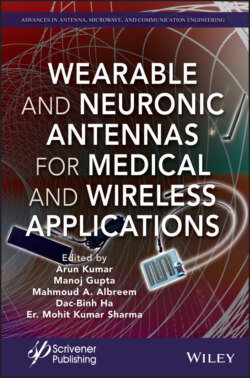Wearable and Neuronic Antennas for Medical and Wireless Applications

Реклама. ООО «ЛитРес», ИНН: 7719571260.
Оглавление
Группа авторов. Wearable and Neuronic Antennas for Medical and Wireless Applications
Table of Contents
List of Tables
List of Illustrations
Guide
Pages
Wearable and Neuronic Antennas for Medical and Wireless Applications
Preface
1. Machine Learning Aided Channel Equalization in Filter Bank Multi-Carrier Communications for 5G
1.1 Introduction
1.2 Related Literature Review
1.3 System Model
1.4 Existing Methods for Equalization in FBMC. 1.4.1 One-Tap Zero Forcing Equalizer
1.4.2 MMSE Block Equalizer
1.5 Proposed Machine Learning-Based FBMC Equalizer
1.6 Results and Discussion
1.7 Summary
References
2. Implantable Cardio Technologies: A Review of Integrated Low Noise Amplifiers
2.1 Introduction
2.2 Background on Low Noise Amplifiers. 2.2.1 ECG Signal Characteristics
2.2.2 General ECG Readout Amplifier System Architecture and Design Considerations
2.2.3 Low Noise Amplifier Circuit Design
2.2.4 Operational Transconductance Amplifier Circuits Used in LNA Design
2.2.4.1 Typical Telescopic Cascode Amplifier [39]
2.2.4.2 Complementary Input Closed Loop Amplifier [40]
2.2.4.3 Fully Differential Current Reuse OTA [41]
2.2.4.4 Fully Reconfigurable OTA Using Floating Gate Transistors [42]
2.2.4.5 Low Noise OTA with Output Boosting Technique [44]
2.2.4.6 Low Noise Low Power OTA [46]
2.2.4.7 Cross Coupled Load Current Reuse OTA [47]
2.2.4.8 Fully Differential Stacked OTA [48]
2.3 Applications of Low Noise Amplifiers
2.3.1 For Implantable Bio-Sensors
2.3.2 For Measuring and Recording ECG Signal
2.4 Conclusion
References
3. Detecting COVID-19 Through Lung X-Ray Imaging: An Alternative Using Modified CNN Architecture
3.1 Introduction
3.2 Literature Review
3.3 Proposed Methodology
3.3.1 Generative Adversarial Network (GAN)
3.3.2 Convolutional Neural Network (CNN)
3.3.2.1 General Model of CNN
3.3.2.2 Convolutional Network
3.3.2.3 Pooling Layer
3.3.2.4 Fully Connected Layer
3.3.2.5 Activation Function
3.3.2.6 Calculation of Gradient Descent in CNN Architecture
3.3.3 Proposed Algorithm
3.3.4 Model Architecture
3.4 Results
3.5 Conclusion
References
4. Wireless Body Area Network Antenna
4.1 Introduction
4.1.1 On Body WBANs
4.1.2 In Body WBANs
4.1.3 Non-Medical Applications for WBAN
4.1.4 Principle of Operation
4.1.4.1 Transmitter
4.1.4.2 Receiver
4.1.5 Design Aspects of WBANs
4.1.6 Hardware Requirements
4.2 Literature Review
4.3 Proposed Work. 4.3.1 Geometry of Antenna
4.3.2 Parametric Analysis. 4.3.2.1 Effect of Radius of Vias
4.3.2.2 Effect of Length of Feed
4.3.2.3 Effect of Length of Conductive Portion of Ground
4.4 Result
4.5 Conclusion
References
5. Analysis of RF-DC Rectifier Input Impedance for the Appropriate Design of Matching Network for Wireless RF Energy Harvesters
5.1 Introduction
5.1.1 Need and Advantages of Energy Harvesters
5.1.2 RF Energy Sources
5.2 RF Energy Harvesting Processing Block
5.3 Matching Network & RF-DC Rectifier
5.4 Study of Input Impedance of Rectifier
5.5 Conclusion
Acknowledgment
References
6. Secured Schemes for RF Energy Harvesting Mobile Computing Networks with Multiple Antennas Based on NOMA and Access Points Selection
6.1 Introduction
6.2 System and Channel Models
6.3 Performance Analysis and Optimization. 6.3.1 Performance Analysis
6.3.2 Optimization
6.4 Numerical Results and Discussion
6.5 Conclusion
Appendix A
References
7. Performance and Stability Analysis of CNTFET SRAM Cell Topologies for Ultra-Low Power Applications
7.1 Introduction
7.2 CNTFET Based SRAM Memory Cell
7.3 Simulation Results and Comparative Performance Analysis
7.4 Stability Analysis of Proposed SRAM Cells
7.5 Conclusion
References
8. Arrow Shaped Dual-Band Wearable Antenna for ISM Applications
8.1 Introduction
8.2 Antenna Design
8.3 Results
8.4 Analysis of Specific Absorption Rate (SAR)
8.5 Conclusion
References
9. Edge-Fed Semicircular Antenna Enabled With Pins and Slots for Wireless Applications
9.1 Introduction
9.2 Configuration of Proposed Antenna
9.2.1 Analysis of Notch Loading Antenna
9.2.2 Analysis of Slots in Antenna
9.3 Specifications
9.4 Result and Discussions
9.5 Conclusion
References
10. A Rectangular Microstrip Patch Antenna with Defected Ground for UWB Application
10.1 Introduction
10.2 Antenna Design
10.3 Simulation Results
10.4 Conclusion
References
11. Waveform Optimization in Multi-Carrier Communications for 5G Technology
11.1 Introduction
11.2 Related Literature Review
11.3 System Model: OFDM System
11.4 POPS: A Popular Existing Method for OFDM Waveform Optimization
11.5 Proposed Method for the Waveform Optimization in OFDM Systems
11.6 Results and Discussion
11.7 Summary
References
12. Wearable Antennas for Biomedical Applications
12.1 Introduction
12.2 Need of Wearable Antennas
12.3 Design Considerations for Wearable Antenna
12.4 Materials for Wearable Antenna
12.4.1 Fabric Materials
12.4.2 Non Fabric Materials
12.5 Fabrication Methods for Wearable Antenna
12.5.1 Stitching and Embroidery
12.5.2 Screen Printing
12.5.3 Inkjet Printing
12.5.4 Chemical Etching
12.6 Measurements for Wearable Antenna
12.6.1 Specific Absorption Rate (SAR)
12.6.2 Performance on Human Body
12.6.3 The Bending and Crumpling Effects
12.7 Frequency Bands for Wearable Antenna
12.8 Applications of Wearable Antenna in Biomedical
12.9 Conclusion
References
13. Received Power Based Jammer Localization Using Unscented Kalman Filtering
13.1 Introduction
13.2 Related Work
13.3 System Model
13.3.1 Unscented Kalman Filter (UKF)
13.4 Simulation and Results
13.5 Summary
References
Index
WILEY END USER LICENSE AGREEMENT
Отрывок из книги
Scrivener Publishing 100 Cummings Center, Suite 541J Beverly, MA 01915-6106
.....
(1.9)
where n represents the additive noise term which is usually modeled as Gaussian random variable.
.....